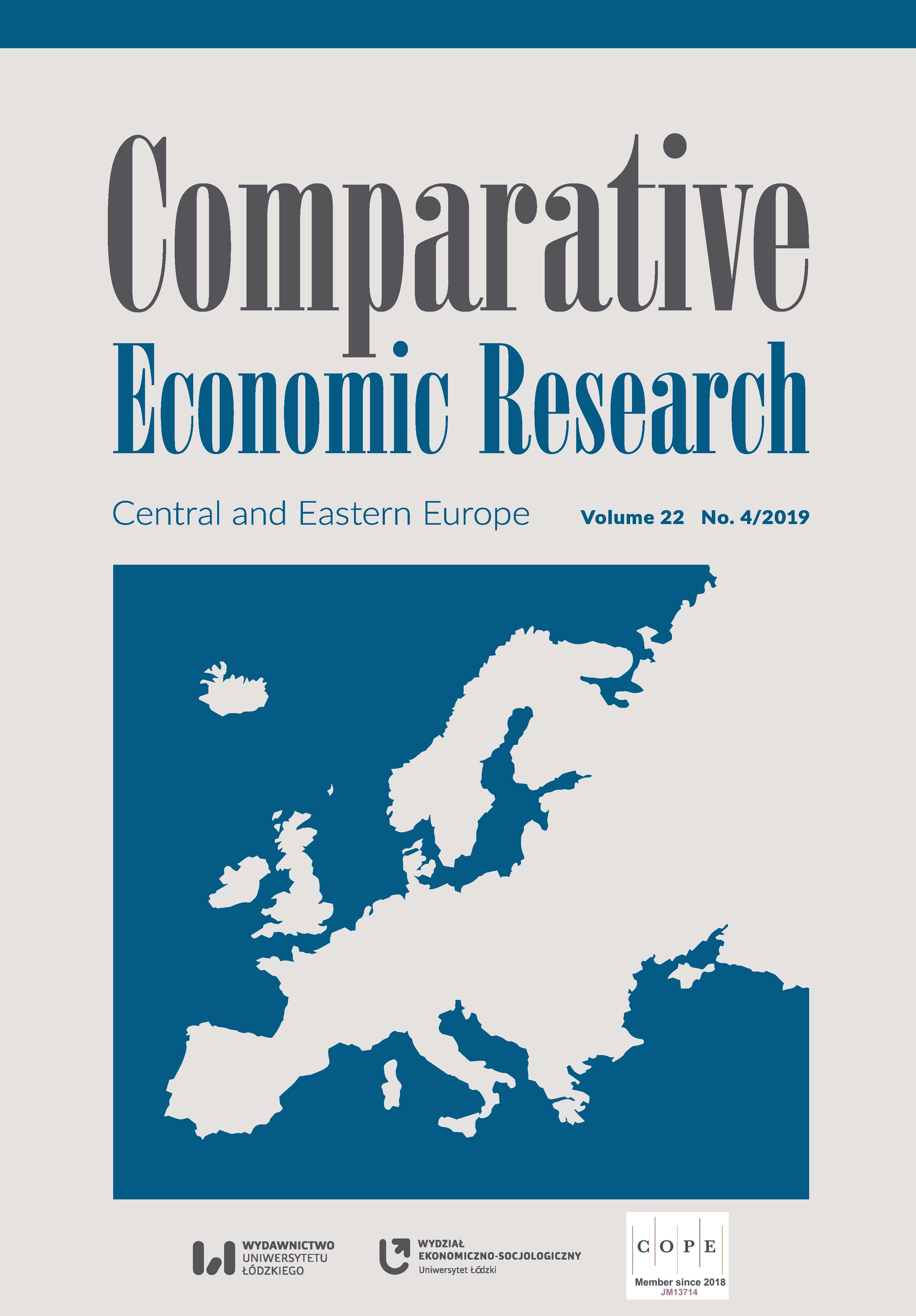A Gravity Model Approach towards Pakistan’s Bilateral Trade with SAARC Countries
DOI:
https://doi.org/10.2478/cer-2019-0030Keywords:
bilateral trade, common language, exchange rate, gravity model, populationAbstract
This research paper attempts to estimate the bilateral trade of Pakistan with SAARC countries using a gravity model of trade. This panel study covers the period from 2003 to 2016. The empirical results are obtained through pooled OLS, fixed‑effects, and random‑effects estimators. On the basis of Hausman test results, the paper concentrates only on the findings of the fixed‑effects model. The empirical findings reveal that the GDPs of both Pakistan and the partner country have a positive impact on bilateral trade. Market size has a negative impact on trade and this is justified on the basis of the absorption effect. Similarly, distance and exchange rate also have a negative correlation with bilateral trade. The study finds that Pakistan has very low trade with India and Afghanistan, despite the common border. A common language has a positive but insignificant impact on Pakistan’s bilateral trade. The Paper also attempts to calculate the trade potential of Pakistan. The findings reveal that Pakistan has high trade potential with all SAARC member countries except the Maldives and Afghanistan.
Downloads
References
Achakzai, J.K. (2006), Intra‑ECO Trade: A Potential Region for Pakistan’s Future Trade, “The Pakistan Development Review”, 45 (3), pp. 425–437.
Google Scholar
Akram, A. (2013), Pak‑SAARC Intra‑industry Trade, PIDE Working Papers, 93.
Google Scholar
Buch, C.M., Kleinert, J., Touba, F. (2003), The Distance puzzle: On the interpretation of the distance coefficient in the Gravity equations. Kiel Working Paper No. 1159.
Google Scholar
Chan‑Hyun S. (2005), Does the gravity model explain South Korea’s trade flows?, “The Japanese Economic Review”, 56 (4), pp. 417–430.
Google Scholar
Cho, G., Sheldon, I., McCorriston, S. (2002), Exchange Rate Uncertainity and Agricultural Trade. “American Journal of Agricultural Economics”, 84, pp. 934–942.
Google Scholar
Eichengreen, B., Irwin, D. (1995), Trade blocs, currency blocs and the reorientation of world trade in the 1930s, “Journal of International Economics”, 38, pp. l–24.
Google Scholar
Gul, N., Yasin, M. (2011), The Trade Potential of Pakistan: An Application of the Gravity Model. “The Lahore Journal of Economics”, 16, pp. 23–62.
Google Scholar
Hassan, R., Rehman, S. (2015), Economic Integration: An Analysis of Major SAARC Countries, “A Research Journal of South Asian Studies”, 30, pp. 95–105.
Google Scholar
Hussain, H. (2017), Globalization and Gravity Model of Trade of Pakistan‑ A PPML Estimator Analysis, “Management and Administrative Sciences Review”, 6, pp. 15–27.
Google Scholar
Kandilov, I.T. (2008), The Effects of Exchange rate Volatility on Agricultural Trade, “American Journal of Agricultural Economics”, 90, pp. 1028–1043.
Google Scholar
Kaur, S., Nanda, P. (2010), India’s Export Potential to Other SAARC Countries: A Gravity Model Analysis, “Journal of Global Economy”, 6 (3), pp. 167–184.
Google Scholar
Oguledo, V.I., MacPhee, C.R. (1994), Gravity Models: a reformulation and an application to discriminatory trade arrangements, Applied Economics, 26, pp. 107–120.
Google Scholar
Panda, R., Sethi, M., Kumaran, M. (2016), A Study of Bilateral Trade Flows of China and India, “Indian Journal of Science and Technology”, pp. 1–7.
Google Scholar
Poyhonen, P. (1963), A Tentative Model for the Volume of Trade between Countries, Weltwirtschaftliches Archiv, 90, pp. 93–100.
Google Scholar
Rahman, M. (2005), The Determinants of Bangladesh’s Trade: Evidence from the Generalized Gravity Model, Working Paper No. 3, University of Sydney, School of Economics.
Google Scholar
Roy, M., Rayhan, I. (2011), Trade Flows of Bangladesh: A Gravity Model Approach, “Economics Bulletin”, 31 (1), pp. 950–959.
Google Scholar
Sakyi, D. (2011), Economic Globalisation, Democracy and Income in Sub‑Saharan Africa: A Panel Cointegration Analysis, Proceedings of the German Development Economics Conference, Berlin 2011, No. 72.
Google Scholar
Sherif, S., Fantazy, K. (2013), Factors Influencing Export in Bilateral Trade, “International Journal of Management, Economics and Social Sciences”, 2, pp. 12–27.
Google Scholar
Shujaat, A. (2015), Economic Survey of Pakistan, (2015–16) Islamabad, Ministry of Finance, Government of Pakistan.
Google Scholar
Sokchea, K. (2006), An analysis of Cambodia’s Trade Flows: A Gravity Model, Working Paper Series, 21464, pp. 1–24.
Google Scholar
Tinbergen, J. (1962), Shaping the World Economy: Suggestions for an International Economic Policy. New York: Twentieth Century Fund, 1962.
Google Scholar
Turkcan, K. (2005), Determinants of Intra‑industry Trade in Final goods and Intermediate Goods between Turkey and Selected OECD Countries, Ekonometri ve Istatistik Say, 1, pp. 20–40.
Google Scholar
Wang, J. (2016), Analysis and Comparison of the Factors Influencing Worldwide Four Kinds of Vegetable Oil Trade: Based on Gravity Model, “Modern Economy”, 7 (2), pp. 173–182.
Google Scholar
Downloads
Published
How to Cite
Issue
Section
License

This work is licensed under a Creative Commons Attribution-NonCommercial-NoDerivatives 4.0 International License.











